Abstract
Background
A number of studies have suggested an increased frequency of cardiovascular (CV) diseases in patients with psoriasis.
Objective
In this study, we assessed the awareness among psoriasis patients and dermatologists in private primary clinics about the increased CV risk linked to psoriasis, and examined the screening behaviors of dermatologists for CV risk factors in psoriasis patients.
Methods
We distributed questionnaires to dermatologists in primary clinics and to psoriasis patients about their awareness of the increased CV risk factors related with psoriasis.
Results
One hundred four patients and 50 dermatologists were included. 64.4% of patients and 92% of dermatologists answered that they know about the increased risk of CV diseases in psoriasis patients. However, far fewer dermatologists than expected followed the screening guidelines for CV risk factors. We found that the duration (p<0.0001) and severity (p<0.0001) of psoriasis were related to patient's awareness. A significant correlation between dermatologists' awareness and the number of psoriasis patients they treated each month was also observed (p<0.024).
Conclusion
This study may help promote the idea that psoriasis patients require education about their increased CV risk factors and that dermatologists require further education about screening practices to detect CV risk in psoriasis patients.
Keywords: Awareness, Cardiovascular diseases, Psoriasis
INTRODUCTION
Psoriasis is a chronic immune-mediated inflammatory disease, characterized by scaly plaques or pustules, with a prevalence rate of approximately 1.5%~3%1,2,3. Recent studies have revealed that systemic inflammatory diseases such as psoriasis, systemic lupus erythematosus, and rheumatoid arthritis are associated with an increased risk of cardiovascular (CV) diseases4. In particular, it has been well established that the prevalence of CV diseases and conventional CV risk factors, such as obesity, smoking, diabetes mellitus, hyperlipidemia, and hypertension, is higher in patients with psoriasis than in the general population5,6,7,8. Moreover, psoriasis is related to high CV mortality rates, whereas its severity is associated with an increased risk of CV disease9,10,11.
Despite previous studies that demonstrated an increased risk of CV disease and the establishment of screening guidelines for CV risk factors in psoriasis patients12, it is not certain whether psoriasis patients and dermatologists are aware of this risk and whether dermatologists follow the recommended screening guidelines. We assumed that dermatologists in private primary practice have relatively fewer opportunities to obtain knowledge about the increased CV risk factors in psoriasis patients than dermatologists working in university hospitals, and we wondered about the awareness and screening behaviors of dermatologists in private primary clinics as well as about the awareness of psoriasis patients. The aims of this study are to assess the awareness among psoriasis patients and dermatologists in primary clinics about the increased CV risks linked to psoriasis, and to evaluate the screening behaviors for CV risk factors among dermatologists.
MATERIALS AND METHODS
Subjects and data collection
First, psoriasis patients were randomly selected among outpatients with psoriasis aged ≥20 years who presented to the Department of Dermatology, Hallym University Sacred Heart Hospital. One hundred four patients, with adequate time to receive an explanation about the study, provide consent, and complete questionnaires, were enrolled between June 1 and December 31, 2013. The patients completed questionnaires about their awareness of increased CV risks linked to psoriasis and the screening behaviors in detecting risk factors (Table 1). To evaluate the clinical variables that are related with patients' awareness, a detailed history was obtained from each patient, including sociodemographic issues and the duration of their psoriasis. Information about the severity of psoriasis, assessed by using the Psoriasis Area Severity Index (PASI), was obtained from the patients' medical records, and the highest score was selected. The patients were questioned about how they obtained the information about increased CV risk factors.
Table 1.
Questionnaire for patients about the awareness of increased cardiovascular (CV) risk in psoriasis patients
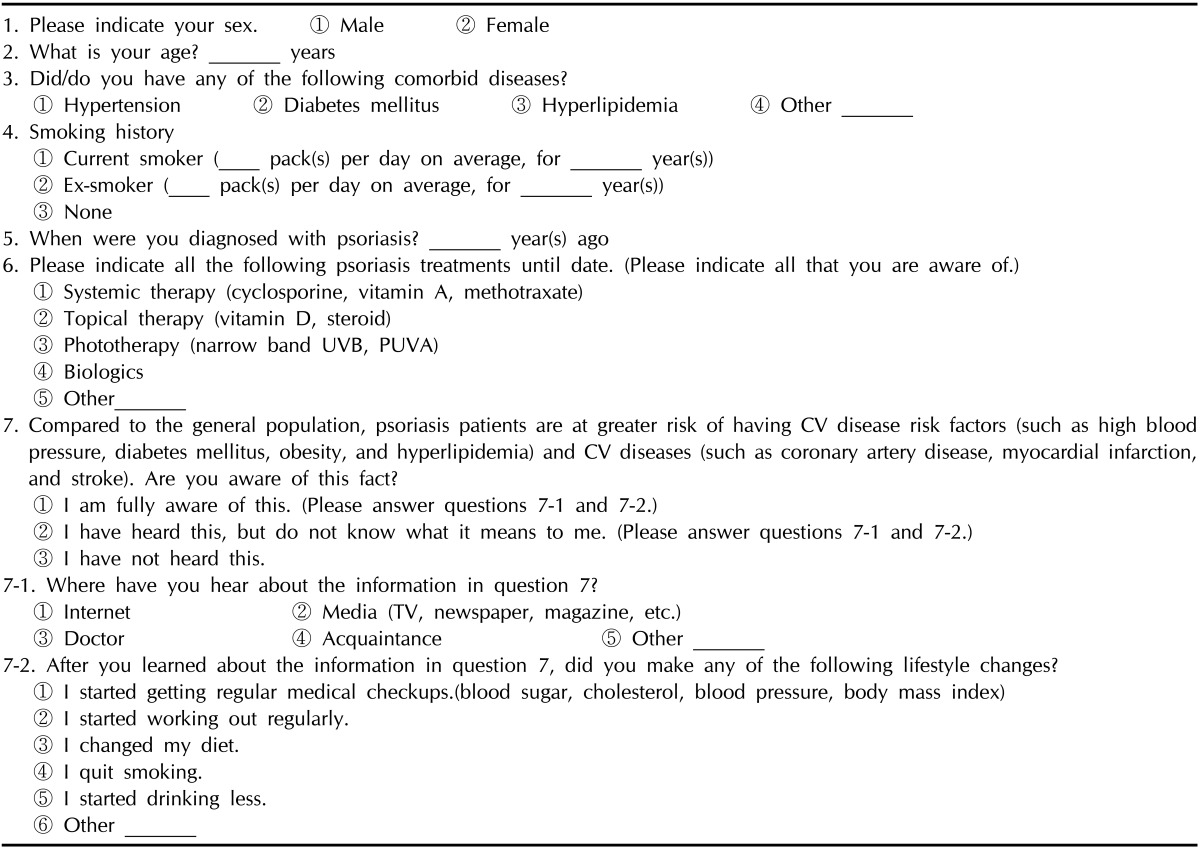
Board-certified, Korean dermatologists practicing in private primary clinics were randomly selected from the Korean Dermatological Association. One hundred questionnaires were distributed through electronic mail. A total of 50 dermatologists completed the questionnaire (Table 2). The questionnaire identified the dermatologists' awareness of the high CV risk factors in psoriasis patients and their screening practices for CV risk factors when treating these patients. To identify the relevant factors associated with their awareness, the dermatologists were asked about the number of patients with psoriasis they treated per month. They were also questioned about their screening methods for CV risk factors.
Table 2.
Questionnaire for dermatologists on the awareness of increased cardiovascular (CV) risk in psoriasis patients
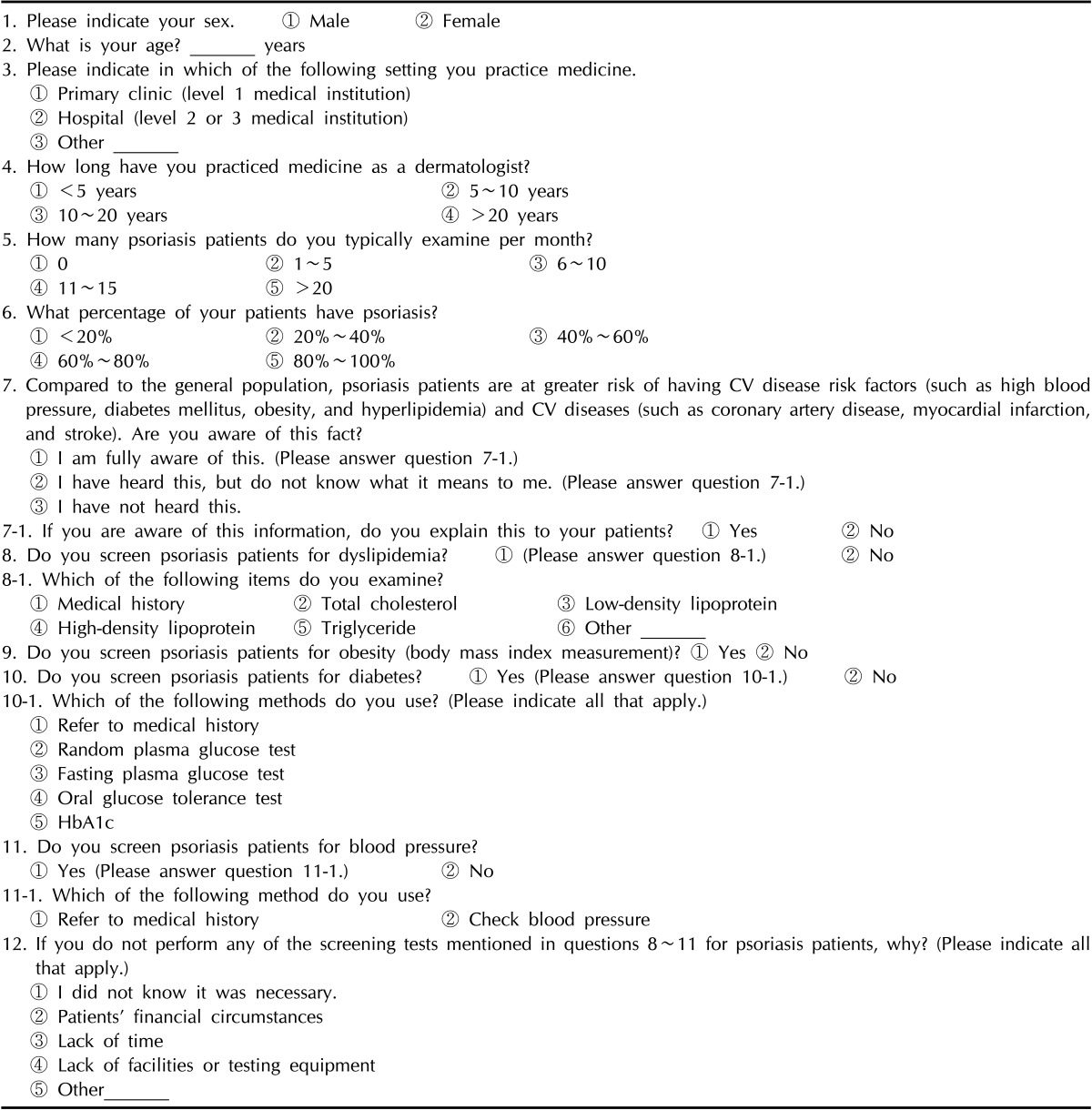
Statistical analysis
Data are expressed as mean±standard deviation. An independent t-test was used to analyze the data. A χ2 test was also used to identify the factors that were related to the awareness of increased CV risk in patients with psoriasis. All statistical analyses were performed by using SPSS ver. 13.0 (SPSS Inc., Chicago, IL, USA). p-values <0.05 were considered statistically significant.
Ethics statement
This study received approval from the institutional review board of Hallym University Sacred Heart Hospital on May 10, 2013 (IRB No. 2014-I011). Written informed consent was obtained from all participants.
RESULTS
Demographic data of the patients
A total of 104 patients (49 men, 55 women) with plaque type psoriasis were included in this study (Table 3). The mean age of psoriasis patients was 49.7±12.6 years, and the mean duration of psoriasis was 10.5±8.7 years.
Table 3.
Sociodemographic characteristics of the patients (n=104)
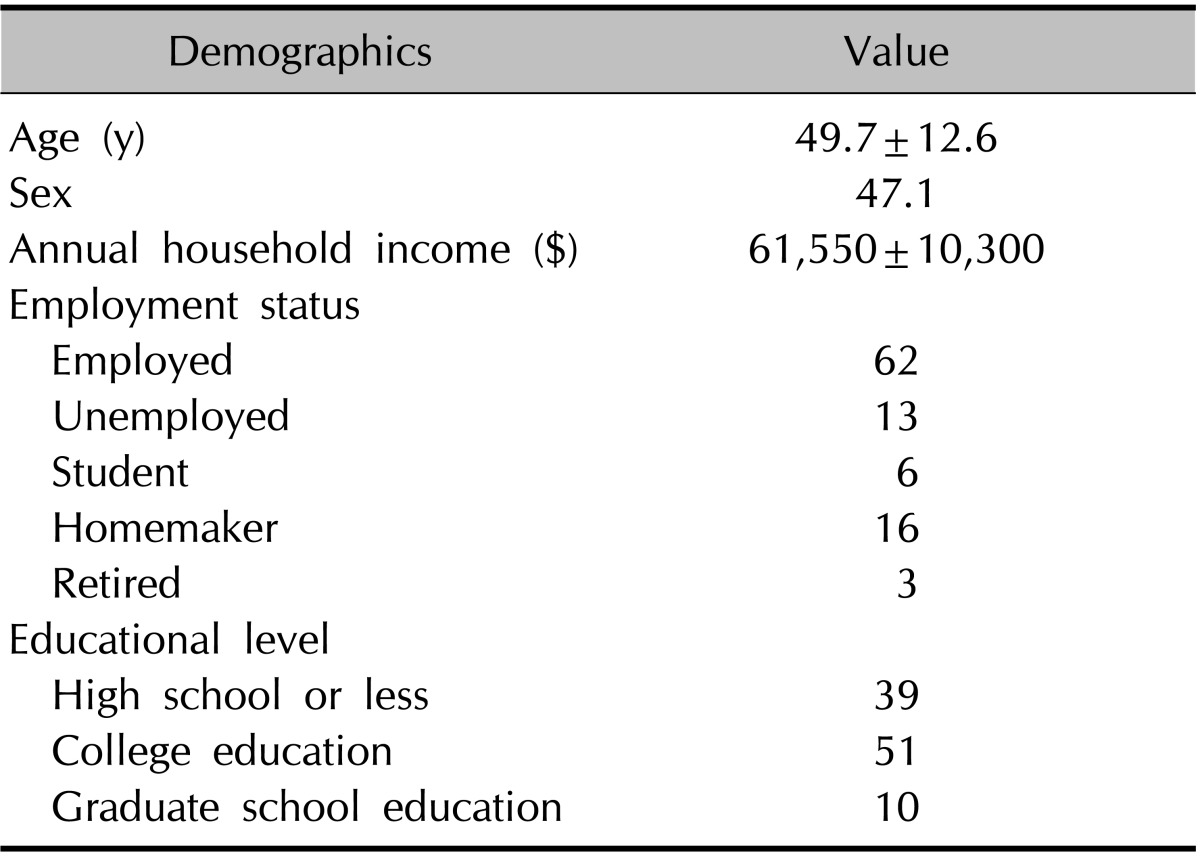
Values are presented as mean±standard deviation or percentage of total subjects.
Awareness among psoriasis patients of their increased CV risk
Only 28 of the 104 (26.9%) patients were well aware of their increased CV risk factors, whereas 39 (37.5%) had heard about the increased CV risk in psoriasis patients. However, these patients did not have a thorough understanding of the risk. The other 37 (35.6%) patients answered that they did not have any idea about their increased risk of CV disease. The way in which patients acquired this knowledge was noted. More than one answer was possible. The most common source of information was mass media (67 patients, 40.3%), followed by the internet (25, 37.3%) and their doctors (18, 26.9%). The patients were also asked whether they had made any efforts to reduce their risk of adverse CV outcome. A total of 53 (79.1%) patients responded that they did, whereas the rest responded that they had made no effort at all. The most common efforts made were exercising and changing dietary habits, accounting for 24 (35.8%) and 21 (31.3%) patients, respectively. Eighteen of the 67 patients (26.9%) received screening such as regular laboratory evaluations, whereas 8 (11.9%) reduced their alcohol consumption, and 6 (9.0%) had quit smoking.
The correlation between patients' awareness and their clinical factors was examined. The mean duration of psoriasis was 10.5±8.7 years, and the mean PASI score was 5.7±3.5. We found that the factors, significantly associated with patients' awareness, were the duration (p<0.0001) and severity (p<0.0001) of psoriasis (Table 4). Among the patients who had psoriasis for <1 year, none were well aware of their increased CV risk. Eight of the 16 (50.0%) patients who had psoriasis for >20 years showed the greatest awareness. Although only 17 (19.3%) patients with mild psoriasis were well aware of their increased CV risk, a larger proportion (11 of 16, 68.8%) of patients with moderate to severe psoriasis were well aware of their increased CV risk. There was no sex- or age-related predominance in awareness among the participants of this study.
Table 4.
Comparisons of awareness of psoriasis patients by clinical factor
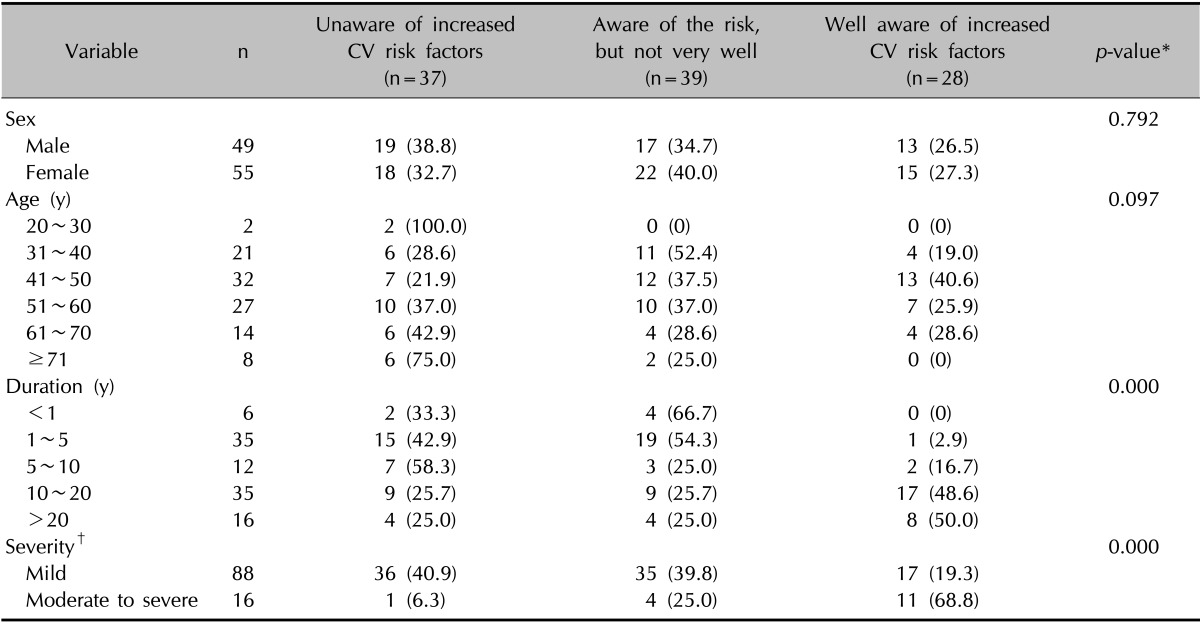
Values are presented as number of subjects (percentage of total). CV: cardiovascular. *p-values<0.05 considered statistically significant. †The patients with a Psoriasis Area Severity Index (PASI) score <10 were considered to have mild psoriasis, whereas those with a PASI score ≥10 were considered to have moderate to severe psoriasis.
Awareness among dermatologists of increased CV risk
Forty-six of the 50 (92%) dermatologists were aware that psoriasis patients have a greater CV risk than the normal population. Thirty-six (72%) dermatologists were well aware of the risk, whereas the other 10 (20%) had heard of the increased risk, but did not know much about it. The mean duration of clinical practice was 12.1±9.0 years, and the mean number of psoriasis patients that the dermatologists treated per month was 7.1±5.0. A significant correlation between dermatologists' awareness and the number of psoriasis patients they treated per month was observed (p<0.024; Table 5). None of the dermatologists who treated no patients with psoriasis were well aware of the increased CV risk factors, whereas the four dermatologists who treated >20 patients per month recognized the risk factors well. The duration of clinical practice was not significantly related to their awareness.
Table 5.
Comparisons of dermatologist awareness according to the number of psoriasis patients and duration of clinical practice
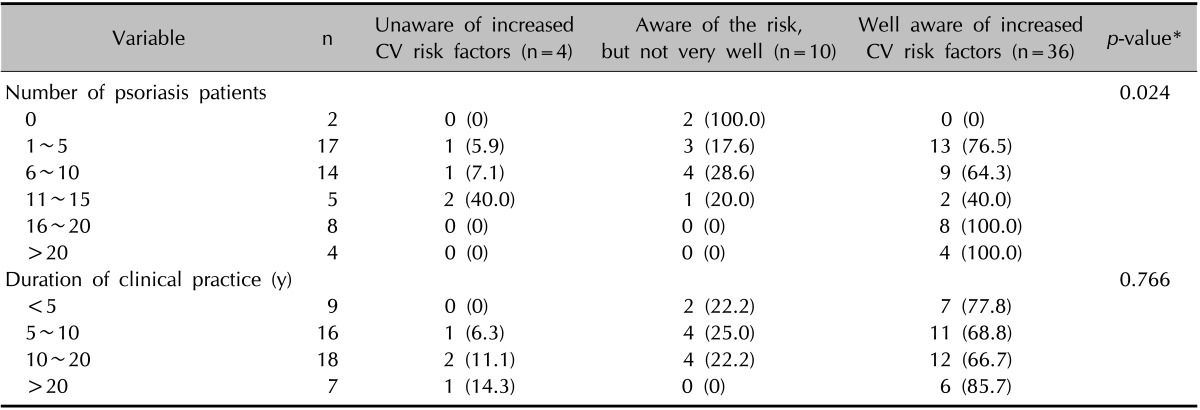
Values are presented as number of subjects (percentage of total). CV: cardiovascular. *p-values<0.05 considered statistically significant.
Despite their awareness, the number of dermatologists who screened psoriasis patients for CV risk factors was far less than expected. Five of the 36 (13.9%) dermatologists screened patients for dyslipidemia, 17 (47.2%) for obesity, 11 (30.6%) for hypertension, and 10 (27.8%) for diabetes mellitus. The reasons why the dermatologists did not screen for CV risk factors were a lack of screening facilities (50%), lack of time (27.1%), lack of feeling the need to perform screening (20.2%), and lack of patient compliance (12.2%). Four dermatologists answered that they did not know exactly what they had to do to evaluate a patient for CV risk factors.
DISCUSSION
In this study, less than half of the psoriasis patients were well aware of their increased CV risk factors. The results of this study suggest that the severity and duration of psoriasis are associated with the awareness of CV risk factors in psoriasis patients. The severe group with PASI ≥10 tended to be more aware of the high CV risk factors related with psoriasis. The results also revealed that patients who had psoriasis for a longer duration recognized their risk better than those who had psoriasis for a shorter duration. Whether duration or severity was correlated with the increased CV risk is controversial; however, the patients' awareness in this study was related to the duration and severity of their psoriasis. We assume that this relation exists because psoriasis patients with longer duration and higher severity are likely to have more opportunities to obtain information about increased CV risk during their long and severe disease course.
We also found that patients acquired their knowledge about the increased CV risk factors more often through non-professional channels than from their doctors. This finding suggests that most dermatologists do not educate their patients about their increased CV risk factors or their need to undergo screening. Less than half of these patients were routinely screened for CV risk factors, such as through regular laboratory evaluations, and we can assume that this result reflects low patient awareness, as this study showed.
On the other hand, most of the dermatologists responded that they know about the increased CV risk factors of psoriasis patients. Increasing numbers of studies about the co-morbidities of psoriasis, especially CV co-morbidities, have been established; this may have contributed to the dermatologists' awareness13,14. This study revealed that dermatologists who treated a greater number of psoriasis patients were more likely to be well aware of the increased CV disease risk and more likely to screen for risk factors. An extensive experience with psoriasis patients has helped dermatologists learn more about their CV risk factors. The duration of clinical practice was not significantly related to the dermatologists' awareness. We can assume that dermatologists who have had a longer practice are likely to have fewer opportunities to obtain the latest knowledge such as on the co-morbidities of psoriasis. However, we can also carefully speculate that dermatologists with a longer duration of practice have more experience treating psoriasis patients, resulting in their increased awareness. These two possible contrasting ideas may be helpful in understanding our data, which showed no significant findings between the dermatologists' awareness and their duration of clinical practice.
Our study also found that the dermatologists did not always screen for CV risk factors, such as hypertension, dyslipidemia, diabetes mellitus, and obesity. Most of the dermatologists responded that they did not screen for CV risk factors because of a lack of facilities. This result is consistent with the fact that obesity and hypertension, which are much easier to check in outpatient clinics, seem to be screened at higher rates than other risk factors. Notably, more than half of the dermatologists who were aware of the high CV risk factors in psoriasis patients did not educate their patients about this risk despite their awareness. In an effort to reduce CV risk factors in psoriasis patients, the National Psoriasis Foundation recommended the use of the American Heart Association guidelines, and suggested that psoriasis patients be screened for CV risk factors starting at 20 years of age15. Wohlrab et al.16 recently developed a checklist that allows dermatologists to detect all relevant factors related to the co-morbidities of patients with moderate to severe psoriasis, and they emphasized the importance of interdisciplinary complementary assessments.
Overall, the findings of this study suggest that although most dermatologists are aware of the greater CV risk factors and CV disease rates in psoriasis patients, only a small proportion of psoriasis patients are well aware of their risk. Dermatologists should feel a responsibility to educate their patients and screen for CV risk factors on the basis of accurate knowledge about the association between psoriasis and CV diseases. In addition, larger, multi-institutional studies are needed to confirm the factors related to the awareness of increased CV risk factors.
This study has several limitations. First, it used questionnaires distributed by electronic mail to dermatologists, which means the possibility of statistical bias is present. Second, the awareness of increased CV risk factors can differ according to the existence of CV diseases in psoriasis patients. Further studies with matching co-morbidities are needed.
References
- 1.Rapp SR, Feldman SR, Exum ML, Fleischer AB, Jr, Reboussin DM. Psoriasis causes as much disability as other major medical diseases. J Am Acad Dermatol. 1999;41:401–407. doi: 10.1016/s0190-9622(99)70112-x. [DOI] [PubMed] [Google Scholar]
- 2.Schön MP, Boehncke WH. Psoriasis. N Engl J Med. 2005;352:1899–1912. doi: 10.1056/NEJMra041320. [DOI] [PubMed] [Google Scholar]
- 3.Federman DG, Shelling M, Prodanovich S, Gunderson CG, Kirsner RS. Psoriasis: an opportunity to identify cardiovascular risk. Br J Dermatol. 2009;160:1–7. doi: 10.1111/j.1365-2133.2008.08874.x. [DOI] [PubMed] [Google Scholar]
- 4.Griffiths CE, Iaccarino L, Naldi L, Olivieri I, Pipitone N, Salvarani C, et al. Psoriasis and psoriatic arthritis: immunological aspects and therapeutic guidelines. Clin Exp Rheumatol. 2006;24(1 Suppl 40):S72–S78. [PubMed] [Google Scholar]
- 5.Neimann AL, Shin DB, Wang X, Margolis DJ, Troxel AB, Gelfand JM. Prevalence of cardiovascular risk factors in patients with psoriasis. J Am Acad Dermatol. 2006;55:829–835. doi: 10.1016/j.jaad.2006.08.040. [DOI] [PubMed] [Google Scholar]
- 6.Mallbris L, Ritchlin CT, Ståhle M. Metabolic disorders in patients with psoriasis and psoriatic arthritis. Curr Rheumatol Rep. 2006;8:355–363. doi: 10.1007/s11926-006-0065-8. [DOI] [PubMed] [Google Scholar]
- 7.Henseler T, Christophers E. Disease concomitance in psoriasis. J Am Acad Dermatol. 1995;32:982–986. doi: 10.1016/0190-9622(95)91336-x. [DOI] [PubMed] [Google Scholar]
- 8.Choi WJ, Park EJ, Kwon IH, Kim KH, Kim KJ. Association between psoriasis and cardiovascular risk factors in Korean patients. Ann Dermatol. 2010;22:300–306. doi: 10.5021/ad.2010.22.3.300. [DOI] [PMC free article] [PubMed] [Google Scholar]
- 9.Wakkee M, Thio HB, Prens EP, Sijbrands EJ, Neumann HA. Unfavorable cardiovascular risk profiles in untreated and treated psoriasis patients. Atherosclerosis. 2007;190:1–9. doi: 10.1016/j.atherosclerosis.2006.07.011. [DOI] [PubMed] [Google Scholar]
- 10.Gelfand JM, Neimann AL, Shin DB, Wang X, Margolis DJ, Troxel AB. Risk of myocardial infarction in patients with psoriasis. JAMA. 2006;296:1735–1741. doi: 10.1001/jama.296.14.1735. [DOI] [PubMed] [Google Scholar]
- 11.Mallbris L, Akre O, Granath F, Yin L, Lindelöf B, Ekbom A, et al. Increased risk for cardiovascular mortality in psoriasis inpatients but not in outpatients. Eur J Epidemiol. 2004;19:225–230. doi: 10.1023/b:ejep.0000020447.59150.f9. [DOI] [PubMed] [Google Scholar]
- 12.Friedewald VE, Cather JC, Gelfand JM, Gordon KB, Gibbons GH, Grundy SM, et al. AJC editor's consensus: psoriasis and coronary artery disease. Am J Cardiol. 2008;102:1631–1643. doi: 10.1016/j.amjcard.2008.10.004. [DOI] [PubMed] [Google Scholar]
- 13.Gisondi P, Farina S, Giordano MV, Girolomoni G. Usefulness of the framingham risk score in patients with chronic psoriasis. Am J Cardiol. 2010;106:1754–1757. doi: 10.1016/j.amjcard.2010.08.016. [DOI] [PubMed] [Google Scholar]
- 14.Mehta NN, Azfar RS, Shin DB, Neimann AL, Troxel AB, Gelfand JM. Patients with severe psoriasis are at increased risk of cardiovascular mortality: cohort study using the General Practice Research Database. Eur Heart J. 2010;31:1000–1006. doi: 10.1093/eurheartj/ehp567. [DOI] [PMC free article] [PubMed] [Google Scholar]
- 15.Kimball AB, Gladman D, Gelfand JM, Gordon K, Horn EJ, Korman NJ, et al. National Psoriasis Foundation. National Psoriasis Foundation clinical consensus on psoriasis comorbidities and recommendations for screening. J Am Acad Dermatol. 2008;58:1031–1042. doi: 10.1016/j.jaad.2008.01.006. [DOI] [PMC free article] [PubMed] [Google Scholar]
- 16.Wohlrab J, Fiedler G, Gerdes S, Nast A, Philipp S, Radtke MA, et al. Recommendations for detection of individual risk for comorbidities in patients with psoriasis. Arch Dermatol Res. 2013;305:91–98. doi: 10.1007/s00403-013-1318-9. [DOI] [PubMed] [Google Scholar]


